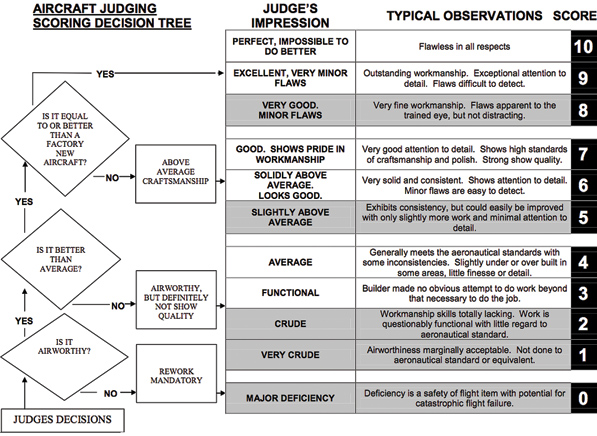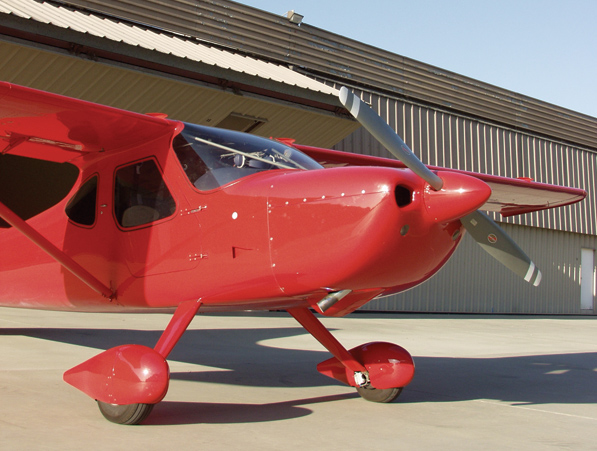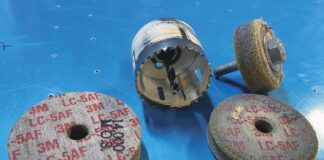
You spent years building the plane of your dreams, and now that it is finished it is time to bring your beauty to AirVenture to be judged by a jury of your peers. A lot of questions are floating around in your head: Exactly what are the judges looking for? How will my simple airplane be judged when compared to a more complex aircraft? And what details will improve my score with the judges?
Scoring
Bob Reece is the Chairman of the EAA Judging Standards Committee and the Chief Judge for EAA AirVenture. He and the Judging Standards Committee have created a simple method for scoring aircraft. A basic decision tree is used to score each of the 10 criteria on a scale from zero to 10, with 10 being "flawless in all respects" and zero representing "major deficiency."
The judging reference guide, EAA’s Aircraft Judging Manual, can be downloaded from the EAA web site at www.airventure.org/awards/judging_manual10.pdf. This document is updated yearly, so be sure to download the current version before heading off to the big show.
Safety of flight issues are covered first in the scoring decision tree. Should the judges determine that an item is not airworthy and "mandatory rework" is required, they will score a zero for the category in which the deficiency was noted. What constitutes "mandatory rework" runs the gamut from poorly secured wires to solid fuel lines where flex lines should be used, to important controls such as a fuel valve being placed out of reach.
Homebuilt aircraft are judged in the following categories: Plansbuilt, Kitbuilt or Classic Homebuilt. Regardless of what category your dream machine fits in, it must meet the Flight and Owner Construction Requirements as outlined in the judging manual. Other aircraft such as warbirds and antiques are judged separately using the appropriate criteria.
Zero to 10 points are given for each of the following items: 1) Overall Appearance, 2) Fuselage, 3) Main Lifting Surfaces, 4) Empennage/Pitch and Yaw Surfaces, 5) Landing Gear and Brakes, 6) Cockpit or Cabin, 7) Powerplant and Prop, 8) Finish, 9) Execution and Innovation, 10) Document of Compliance with FARs.

Aircraft judges scoring tree. (Courtesy EAA.)
Overall appearance is simple in concept: Does the aircraft look good? Is it clean and neat? And, finally, is the level of fit and finish consistent from one section of the airplane to the next? Get all that right, and the aircraft will score a perfect 10 in this category.
Quality of workmanship is the top judging criteria for items two through five, as listed above. The judges are looking for sound structures and good aircraft building practices such as safety wire on appropriate fasteners, sound-looking welds and innovation or improvements to the standard aircraft.
The cockpit or cabin is scrutinized for the builder’s utilization of instruments and controls. Are they arranged neatly and in a safe location? Controls should be within reach of the pilot, and the instrument panel should not look as though it were designed with a shotgun and built with a chainsaw.
The heart and soul of most aircraft is the engine. Judges will not open inspection panels or remove cowlings to inspect the engine. However, they may ask the owner to do so. Neatness and adherence to aircraft construction techniques that produce a safe installation are paramount. The amount of droop or sag of the engine is also taken into account.

Composite aircraft, by their very nature, provide opportunities for smooth, uninterrupted surfaces that can woo judges. Smart builders also work to keep the aircraft as light as possible.
The quality of the finish is more important than the paint scheme or type of finish, paint or polish. The judges recognize that there is a difference in taste, so they do not take into account paint color or design. However, they are looking for paint drips and uniform application of the finish. Of course, underlying blemishes such as pin holes in fiberglass parts are negatives.
Building an airplane is supposed to be an educational process, so the judges appreciate and reward execution and innovation. They are looking for something new, such as new safety features or a modification to an existing feature that makes for an aesthetically pleasing or safer aircraft.
Finally, if the aircraft does not carry with it the required FAA documentation or does not comply with the FARs, don’t even attempt to have your pride and joy judged.
It Has to Fly
Each aircraft eligible for consideration must meet the following flight requirements, as outlined in the EAA’s Aircraft Judging Manual:
1. The aircraft must meet the FAA minimum requirements for the Experimental/Amateur-Built category.
2. The FAA operating limitations restricting flight to a test flight area must have been removed.
3. The aircraft shall have flown to EAA AirVenture or it must be flown during EAA AirVenture.
4. The FAA certification documents must be in order and available for inspection by the judges.
This means that the FAA has blessed your aircraft with an airworthiness certificate emblazoned with Experimental/Amateur-Built, the aircraft has flown off the required Phase I test period as described in its operating limitations, the logbooks have been appropriately endorsed, placing the aircraft in Phase II, it must either be flown to AirVenture or flown during the show, and finally the builder must have the appropriate paperwork and make it available for inspection, should the judges ask.
Finally, the EAA judges require the aircraft to meet the same 51% amateur-built requirement as the FAA. The purpose of the EAA is to promote education through homebuilding, so aircraft built by hired guns need not apply.

Homebuilt judging should be about more than the paint, though Chris Wills’ fiery red GlaStar Sportsman is without question a handsome workhorse, not a hangar queen with a thirst for Meguiar’s.
Yes, Your Honor
When talking with Reece it became evident that the quality of the build is more important than most anythin g else. When asked if the judges give additional points for a complex IFR-equipped instrument panel versus a simple VFR panel, he replied, emphatically, "No! It is important that the panel is well executed. What is in it is not important."
Reece went on to discuss what he and the rest of the judges look for. Initial impressions are important. If a plane does not catch their eye as they approach it, chances are it will not look good upon closer inspection.
Paint quality is judged, not paint schemes (color and design). So while having your aircraft adorned by the best airbrush artist you can afford looks impressive, it will not gain you any more favor with the judges than a simple but well-executed solid color.
While talking about aircraft finishes, Reece was asked how an aluminum aircraft would be judged if all of the rivet heads were filled and the aircraft skins were perfectly smooth. His reply was immediate: "Aluminum aircraft should look like aluminum aircraft. If you want smooth wings, build a composite aircraft." He went on to say that if they are looking at a line of rivets on a structure and one or two rivets are missing, they assume there is a dent hiding under filler and paint. This would only hurt the builder’s chances if the other top aircraft being judged had no such imperfections.
In short, a plane such as an RV with no visible rivet heads would not score well. Perfectly smooth wings and fuselages belong on fiberglass airplanes, and these should have no imperfections such as pinholes or glass weave showing through the paint. Reece added that fabric airplanes should look like fabric planes, and the cloth weave should be visible through the paint (or dope).
Nice touches are techniques such as taking the time to blend fiberglass and aluminum parts together (e.g., fiberglass wingtips on an aluminum wing). However, aesthetically pleasing does not necessarily increase the final number on the aircraft’s scorecard. What is important is that when attaching parts to one another, their joints should be straight and even, with constant and equal gaps and no puckers.
Flight controls always attract the judge’s eye. If they do not line up properly when in the neutral position, such as one drooping aileron, points will be deducted. Large trimtabs or wedges attached to control surfaces are telltale signs that the aircraft does not fly straight, and they may show up on a judge’s scorecard.
Custom touches and modifications to the aircraft should not detract from safety and appearance. However, they can only improve the aircraft’s score if the judges know about them. This is where staying with the aircraft to answer the judge’s questions, removing the cowl upon request or having a storyboard pointing out select features can help. The judges are always impressed by innovation, but even if you improved your aircraft by selecting someone else’s innovations that are not standard on your model aircraft, make sure to point them out and explain why these changes are important.
When the judge approaches your aircraft let him do his job, but be prepared to answer any questions and point out the innovations mentioned earlier. Listen to the judge’s comments, and he will tell you exactly what he and the other judges have observed and what you need to do to improve your score.

Winning an award is the culmination of tremendous effort by the builder.
This Old Bird?
Aircraft that are submitted for consideration do not have to be brand new with only post Phase I fairy time. The judges expect these airplanes to be flown and show some signs of use, so a homebuilt that has been cared for and maintained could still show and score well.
Once an aircraft is awarded Grand Champion, it is no longer eligible for judging at AirVenture. If the aircraft is recognized as a runner-up (Reserve Grand Champion, Champion Homebuilt or Outstanding Workmanship awards), the owner may present the aircraft for judging in subsequent years. However, each year the bar is raised a little higher, and an aircraft that won Grand Champion five years ago would perhaps not get a second look today.
How Good is Good Enough?
There is a significant difference in terms of time and money between airworthy and Grand Champion, and it is up to you, the builder, to determine what type of aircraft you want to build. In the end, it is your airplane, and only you can decide to build something that you will be proud to own and fly.

![]()
Bill Repucci was handed his Private Pilots certificate back in the days when the written test was taken with a Number 2 pencil. At the time, Bill was told that he now had a License to Learn. And learn he did, mostly that there was humor buried in the quirky ways of those of us who call ourselves aviators.





